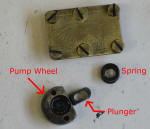Royal Enfield Oil Pump (1920s)
Here are some observations about the oil pump used on Royal Enfields during the 1920s. The information may or may not be correct but is based upon my garage and road experiences.
The oil supply should have a filter in the tap to keep it clean. Beware : if you use a very fine gauze with heavy oil in a cold climate the oil flow may not be enough. Many vintage style taps available today have a fine gauze mesh that is designed for petrol rather than oil. It should be ok to enlarge the mesh in some places in the filter.
When you're riding check to see if you are leaving a smoke haze. Usually these Enfields have just the right amount of oil delivered to the engine and there is little to see. When you're doing this, don't crash into a hedge! You just need to be satisfied that the engine is receiving oil. When it's running you should be able to forget about it so long as you remember to turn on the tap.
These pumps can sometimes 'wet sump' so it is advisable to turn off the oil when the engine is stopped. If you do manage to fill the sump with oil it will be obvious when you try to start it. If this happens do not run the engine before draining out the excess oil first.
1) The pump should be given a clean every so often. Grit can accumulate inside the pump wheel which will reduce its capacity.
2) The pump body should have its oil feed disconnected and the three fixing screws undone. The pump then should pull off. if any silicone has been used then it may need pulling a bit harder but do not force it as the worm teeth are delicate. Clean all oil ways and blow out the dirt. Keep the brass plate removed for now.
3) When you reassemble the pump to the engine, make sure that there is no silicone anywhere near the hole that supplies oil to the engine. Silicone is not required and a paper gasket should do the job properly but do check the alignment of the oil supply hole. When you push the pump onto the engine do not force it, you may need to rotate the engine or pump gear to find a happy meeting point.
4) Insert the three screws but do not tighten yet (because one of the screws may foul an engine nut so you may need to pull the pump away from the engine to tighten this screw). Connect the oil supply and turn on the tap. You should see the chamber begin to fill with oil. Turn off the tap.
5) Re-assemble the pump innards and tighten the six screws that hold down the brass plate. Now tighten the three screws that hold the pump to the engine. Do not over tighten them.
6) If you haven't used the Enfield for years or have just rebuilt the engine then it is good to give a few handfuls of the manual oil pump to get some oil in the sump. There must be oil in the sump as this splashes around and oils the bore.

The plunger moves in and out of the pump wheel. The plunger is controlled by a rotating eccentric pin.

The pump wheel alternates position with the feed hole being aligned with either the oil feed hold or the engine supply hole. The pull/push hole must be 100% clean so remove any dry hardened soil.
